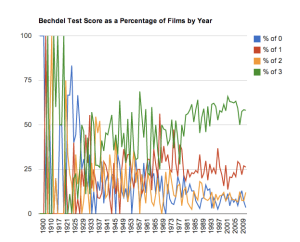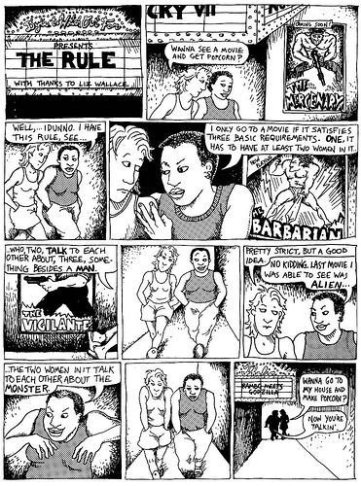Here is a blog that outlines the background of the Bechdel test pretty neatly and has some really good points.
A key thing to note is that the test is no marker of quality or of feminist intention. There are probably loads of porn films where two women called Starr and Tiny-Surgically-Augmented-Flaps ask each other questions like ‘how does that feel?’ and wondering aloud if the other woman might be a ‘dirty bitch’* Let’s not forget the intrinsically terrible Sex & The City films pass the test, so we know it’s certainly no marker for quality.
The test simply asks if the film has women in it to the extent that nearly every other film ever has men in it. I’m trying to compile a list of films that fail the reverse Bechdel (2 men, speak to each other, about something other than a woman). So far that list is:
Bridesmaids
And that’s it. I’m sure there are more that I can’t think of. Let me know in the comments if you can come up with one.
Richard Ash made this graph using data from Bechdeltest.com. It’s not definitive because the data is created by users who add films and decide if they pass the test or not and quite a few are disputed. Also, the results would be skewed by the choice of what films are added to the site and by whom, as not all films are listed.  Still, it’s nice to have a graph, isn’t it. What you can see from it is that around 50% of the films on bechdeltest.com in the last 50 years fail the test. Hey, 50% doesn’t seem bad, does it? But it is, my friends. Take the reverse Bechdel test as a control. If 50% of films failed the reverse Bechdel then 50% passing the Bechdel would work out even. I don’t have data on how many films fail the reverse Bechdel but from the list above I would guess it’s less than 5%, probably less than 1%.
Still, it’s nice to have a graph, isn’t it. What you can see from it is that around 50% of the films on bechdeltest.com in the last 50 years fail the test. Hey, 50% doesn’t seem bad, does it? But it is, my friends. Take the reverse Bechdel test as a control. If 50% of films failed the reverse Bechdel then 50% passing the Bechdel would work out even. I don’t have data on how many films fail the reverse Bechdel but from the list above I would guess it’s less than 5%, probably less than 1%.
I’m not mathsy, but I’d say that men are represented in films approximately a fuckton more than women. Hopefully, the graph will start creeping up as women work towards social equality across the world. More women in notable positions means more women making big decisions (like whether to produce certain films). Hopefully, more women directors and writers. More women in prominent historically interesting situations for film makers to make films about and so on.
I say “and so on” like it’s just altering how much cereal you put in your bowl compared to milk. These are all slow-moving processes that take time and women of exceptional ability to change. Take for example women writers. From what I’ve seen, even women writers write more parts for men because that is what gets produced. You can’t just change the entire industry by changing the gender of one key position. If women writers wrote loads of stuff with women in, it most likely wouldn’t get made because that would be too different to the status quo and what is commercially successful.
Demanding that my cinema films pass the test is my small act to encourage change. I will only give money to those films that pass. It’s a consumer action that will have zero immediate effect on the film industry, but possibly if more people made that demand (despite the risk of ‘missing out‘) then the production companies would take notice. The movie industry would stop making films that failed the test if no one paid to watch films without women in them.
*I don’t theoretically have a problem with porn. I don’t think it has to objectify women, there could be great porn which doesn’t. Unfortunately, I think the industry has generally created an horrific role for women to play and it’s rare to see the opposite. I’d be well into it otherwise.
